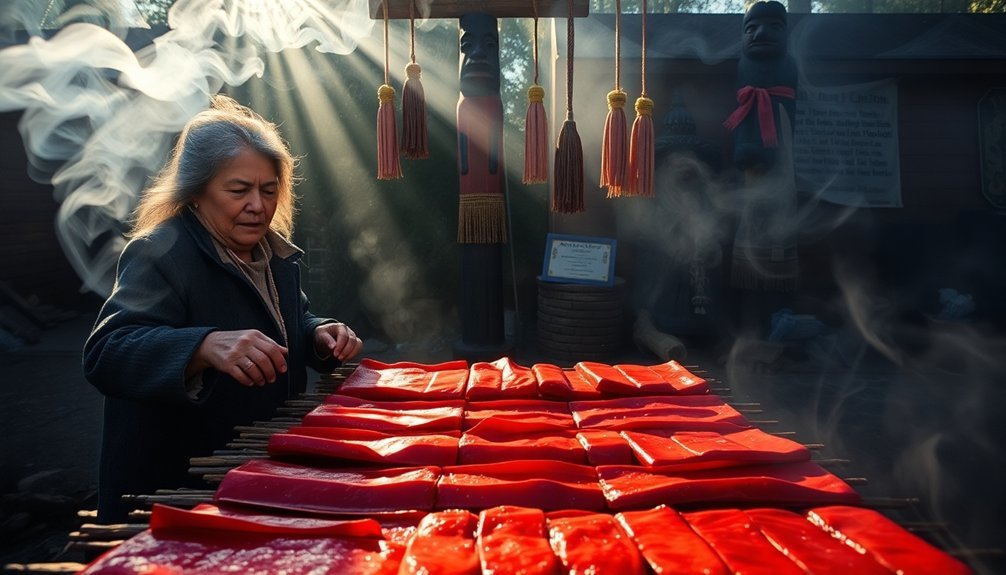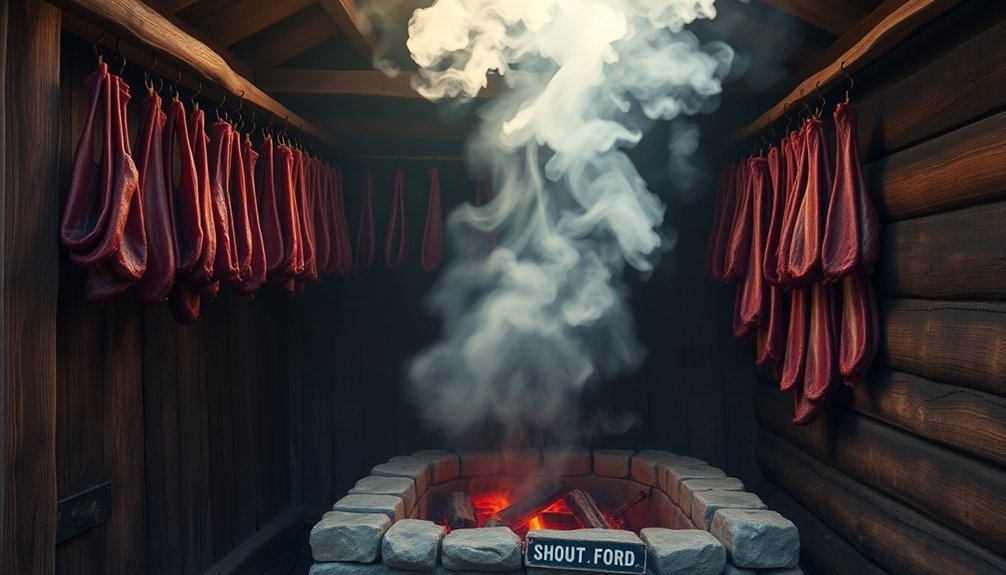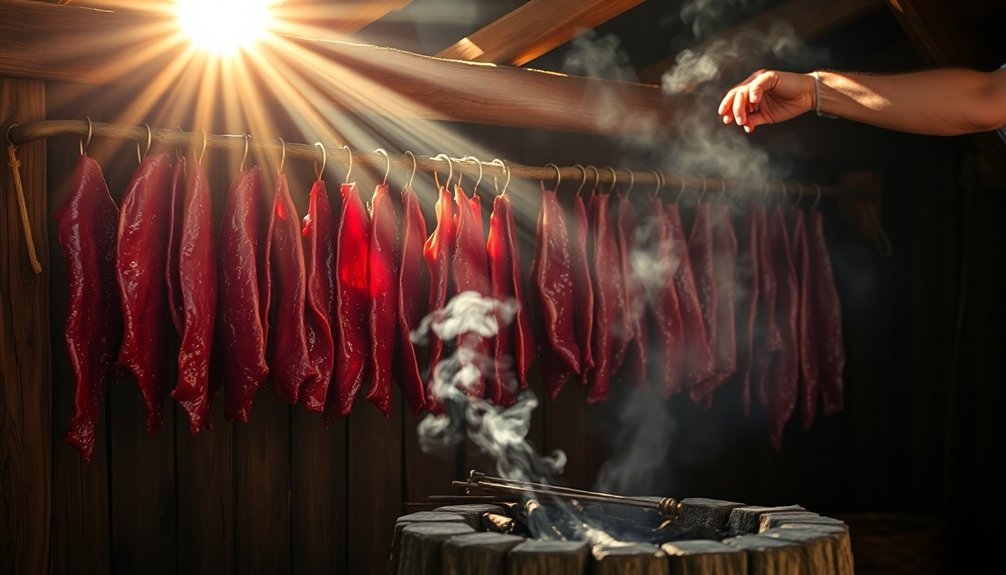Indigenous meat smoking traditions reflect thousands of years of cultural wisdom and innovation. You'll find these practices deeply rooted in spiritual ceremonies and survival techniques across continents, from Native American tribes to Aboriginal communities. Traditional methods combine specific hardwoods like hickory and oak for robust flavors, while fruitwoods add subtle sweetness to various meats. Ancient preservation techniques have evolved into modern practices that honor ancestral knowledge while adapting to contemporary needs. Whether you're interested in the cultural significance or unique flavor profiles, the world of indigenous meat smoking offers a rich tapestry of heritage waiting to be discovered.
Ancient Roots of Meat Smoking

Wisps of smoke billowing from prehistoric fires marked humanity's first steps into meat preservation. When you look back at our ancestors, you'll find that smoking meat wasn't just about flavor – it was vital for survival. Early humans discovered that meat exposed to smoke lasted longer and developed unique tastes, especially in humid regions where simple drying proved ineffective.
You'll find evidence of meat smoking across ancient civilizations, from the pyramids of Egypt to the forums of Rome. Indigenous peoples across North and South America developed sophisticated smoking methods that still influence modern techniques. The basic technique remained consistent: communities would hang their meat over fires or place it in rudimentary smokehouses, allowing the smoke to work its preservative magic. This method proved essential for stockpiling food reserves during harsh seasons.
Early smokers didn't need complex equipment – they created effective preservation systems using the materials at hand. When you examine these ancient practices, you'll notice how they laid the groundwork for modern smoking techniques.
The process was more than mere food preparation; it represented humanity's ingenuity in ensuring food security. These early methods demonstrated that you could transform perishable meat into a stable, long-lasting food source through the simple application of smoke and patience.
Traditional Woods and Their Flavors
Every successful smoke begins with choosing the right wood, as different varieties impart distinct flavors to your meat. For robust, hearty flavors ideal for beef and pork, you'll want to use hickory or oak. If you're smoking brisket, these woods are your best choices, though mesquite can work if used sparingly due to its intense flavor profile. Pecan wood provides rich, nutty undertones perfect for enhancing pork and beef dishes.
When you're working with poultry or more delicate meats, fruitwoods offer excellent options. You'll find apple wood adds a subtle sweetness that won't overpower chicken or turkey, while cherry wood not only provides a sweet, fruity taste but also gives your meat an attractive rosy hue.
For fish, particularly salmon, alder wood's light, sweet flavor has been a traditional choice in Pacific Northwest cooking.
Regional woods can add unique character to your smoked meats. If you're in New Mexico, you might try pinon for its nutty smoke with beef or venison.
When smoking cheese or lighter meats, lilac's mild, sweet smoke offers an interesting alternative. Remember that stronger woods like black walnut work better when mixed with milder varieties to avoid overwhelming bitterness.
Cultural Ceremonies and Smoking Rituals

Across vast landscapes and diverse cultures, Indigenous smoking ceremonies have shaped spiritual and communal practices for thousands of years. You'll find these rituals deeply woven into both Aboriginal Australian and Native American traditions, where smoke serves as a bridge between the physical and spiritual worlds.
In Aboriginal culture, you'll witness smoking ceremonies that use native plants for their cleansing and healing properties. The emu bush, known for its antimicrobial qualities, plays an essential role in these rituals that mark significant life events and Welcome to Country ceremonies. Community elders and members carry smoldering coals and wet leaves during these sacred practices.
When you participate, you're engaging in practices that date back millennia.
Native American tobacco ceremonies differ in their approach but share similar spiritual significance. You'll see tobacco used in various forms to seal agreements between tribes, treat ailments, and communicate with the supernatural domain.
The calumet ritual, in particular, demonstrates how smoking ceremonies strengthen community bonds.
Today, these traditions continue to evolve while maintaining their cultural importance. You'll find contemporary Aboriginal smoking ceremonies incorporating traditional plants and chants, while Native American communities preserve their tobacco rituals as a crucial part of their heritage and identity.
Indigenous Smoking Techniques Worldwide
The art of indigenous meat smoking across continents reveals fascinating variations in the woods and flavors used, from hickory in North America to oak in Spanish smokehouses.
You'll find spiritual significance in many cultures' smoking practices, where specific woods aren't just chosen for flavor but also hold ceremonial importance.
These sacred smoking traditions have shaped modern preservation techniques while maintaining their cultural connections, as seen in Native American influence on American barbecue and Japanese bonito smoking for dashi.
Traditional Woods and Flavors
Many indigenous cultures worldwide have developed unique meat-smoking techniques using locally available woods and spices. In North America, Native American tribes traditionally use hardwoods like hickory, oak, and maple, often constructing tripod smokers in the wilderness to preserve wild game and fish.
You'll find these practices deeply rooted in their cultural heritage.
In South America, particularly in the Amazon rainforest, indigenous peoples have established distinct smoking methods using local woods and specialized smokehouses. Brazil and Argentina continue these traditions today.
Africa's smoking practices vary considerably by region, with communities using native woods and spices passed down through generations to create unique flavor profiles in their meats and fish.
European smoking traditions are especially prominent in Germany, Poland, and Italy, where you'll find distinctive smoked sausages and cured meats. They primarily use hardwoods like oak and beech, while Scandinavian countries have mastered the art of smoking fish, particularly salmon.
These regional variations reflect the diverse ecosystems and available resources of each area, with communities adapting their smoking techniques to local materials and cultural preferences.
Sacred Smoking Rituals Explored
Beyond their practical preservation methods, sacred smoking rituals hold profound spiritual significance in indigenous cultures worldwide.
You'll find that Native American communities use sacred pipes as channels of communication with divine beings, incorporating specific colors and motifs that represent their cosmology. During these ceremonies, they'll often make invocations to six directions, connecting the physical and spiritual domains.
In Aboriginal Australian culture, you'll encounter smoking ceremonies that serve both spiritual and physical cleansing purposes. These rituals involve burning native plants to produce smoke that purifies spaces and people, particularly during birth, initiation rites, and Welcome to Country ceremonies.
The smoke's interaction with different body parts symbolizes varied connections to the land and community.
The plant species used in these sacred practices are diverse and carefully chosen. Native American communities have historically utilized about 100 different plant species, each selected for its specific medicinal and spiritual properties.
Today, many indigenous communities continue to preserve these sacred smoking traditions while distinguishing them from commercial tobacco use, ensuring their cultural practices remain protected under legislation like the American Indian Religious Freedom Act.
Preservation Methods Through Time

Indigenous cultures across North America mastered diverse meat preservation techniques that sustained their communities throughout the seasons. You'll find smoking was an essential method, where meats were exposed to hardwood smoke at temperatures between 150°F and 225°F, creating both flavor and long-lasting preservation.
When you examine traditional curing methods, you'll notice how salt played a significant role, often combined with spices and sugar to draw out moisture and prevent spoilage. The Inuit, for instance, expertly cured salmon to guarantee winter sustenance.
You'll discover that jerky production was equally important, involving careful fat removal and meat cutting before sun-drying or smoking the strips.
Perhaps the most ingenious preservation method you'll encounter is pemmican, where dried meat was pounded into powder and mixed with fat and berries. The Lakota's wasna, made with buffalo meat, choke cherries, and kidney fat, exemplifies this high-calorie preservation technique.
You'll appreciate how these methods weren't just about preservation – they required specific tools and techniques that influenced the final product's taste and texture, allowing communities to maintain their food supplies throughout the year.
Modern Indigenous Smoking Practices
Traditional smoking practices continue on through modern Indigenous communities, blending time-honored techniques with contemporary adaptations. You'll find today's Indigenous meat smoking striking a delicate balance between preserving cultural heritage and meeting modern food safety standards.
| Traditional Element | Modern Adaptation |
|---|---|
| Community-based smoking | Documented safety protocols |
| Seasonal timing | Year-round production capability |
| Sacred wood selection | Certified wood sourcing |
| Family knowledge transfer | Formal training programs |
| Ceremonial practices | Commercial production methods |
In many communities, you'll see smoke houses and traditional structures like the Sámi lávvu still in active use, though they've been modified to meet current regulations. The smoking process remains a community affair, but now includes modern documentation and safety measures. You'll notice that while specific woods are still carefully selected for smoking, they're now often stored in controlled environments to guarantee consistent quality.
Economic sustainability has become a vital focus, with many Indigenous producers developing small-scale commercial operations. They're creating products that honor traditional methods while meeting global market demands, assuring their cultural practices remain viable in today's world.
Sustaining Ancient Food Knowledge

According to ancestral wisdom, meat smoking techniques represent more than just food preservation – they embody entire knowledge systems passed down through generations. When you explore these traditions, you'll discover they're deeply woven into the fabric of indigenous cultures worldwide, from Native American smoke houses to Viking preservation methods.
To understand the depth of this knowledge, consider these critical aspects:
- Indigenous food systems encompass extensive relationships between land, water, air, and culturally significant species that have sustained communities for millennia.
- Traditional smoking methods reflect sophisticated environmental understanding, combining local ecosystem knowledge with sustainable practices.
- These preservation techniques serve as educational bridges, connecting modern generations to ancestral wisdom about food sovereignty and security.
You'll find that preserving this ancient knowledge isn't just about maintaining cultural heritage – it's essential for community health and ecological balance.
Through educational programs and initiatives like the Indigenous Food Systems Network, communities are actively working to protect and transmit these valuable traditions.
Frequently Asked Questions
How Long Can Properly Smoked Meat Last Without Refrigeration?
You'll find properly cold-smoked meat can last several months without refrigeration if stored in cool, dry conditions. Hot-smoked meat won't last as long, so you'll need to consume it within a few days.
What Are the Health Risks Associated With Traditional Indigenous Smoking Methods?
You'll face risks from food-borne bacteria like botulism and listeria, plus increased cancer risks from nitrosamines and PAHs. Traditional smoking methods can expose you to harmful chemicals and carcinogens when meat's improperly heated.
Can Traditional Smoking Methods Be Adapted for Urban Environments?
You can adapt traditional smoking methods for urban settings using compact smokers, pellet cookers, or small smokehouses. Choose the right wood, monitor smoke quality, and follow local regulations for successful urban smoking.
How Do Changing Climate Patterns Affect Indigenous Smoking Practices Today?
You'll find climate change disrupts traditional smoking by affecting meat quality, altering wildlife patterns, and making hunting trips unpredictable. It's also harder to dry meat properly due to irregular weather conditions.
What Role Do Women Play in Traditional Meat Smoking Practices?
You'll find women play crucial roles in meat smoking by assisting with preparation, gathering wood, storing meat, and passing down traditions. They're essential in preserving cultural knowledge while supporting the overall smoking process.
In Summary
You're connecting to centuries of ancestral wisdom when you smoke meat using indigenous methods. Whether you're learning about Nordic smoking towers or Australian Aboriginal smoking pits, you'll find these techniques have stood the test of time. By preserving and practicing these traditional smoking methods, you're not just creating delicious food – you're helping keep essential cultural heritage alive for future generations.





Leave a Reply